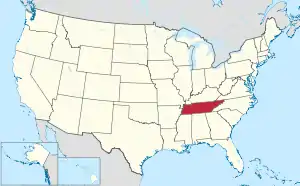
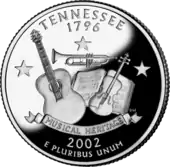
Tennessee, the Volunteer State, has many symbols.
Official symbols of the state are designated by act of the Tennessee General Assembly. The earliest state symbol was the first state seal, which was authorized by the original state constitution of 1796 and first used in 1802.[1] The current seal design was adopted in 1987.
The General Assembly also has officially designated a state slogan, "Tennessee—America at Its Best," adopted in 1965, and a state motto, "Agriculture and Commerce," adopted in 1987 and based on the words on the state seal.[1]
Tennessee's best-known unofficial symbol probably is its nickname, "The Volunteer State", which originated during the War of 1812 when many Tennesseans enlisted in the military in response to Governor Willie Blount's call for volunteers.[1]
State symbols
| State flag | |
 |
Tennessee's state flag, adopted in 1905, has three stars representing the state's three Grand Divisions: West, Middle, and East Tennessee. The designer was LeRoy Reeves of the Tennessee National Guard, who explained: "The three stars are of pure white, representing the three grand divisions of the state. They are bound together by the endless circle of the blue field, the symbol being three bound together in one – an indissoluble trinity."[2] |
| State seal | |
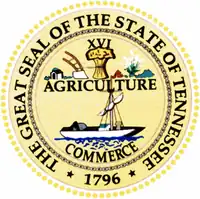 |
Tennessee's current state seal, adopted in 1987, is a modernized version of the seal originally designed in 1801. The seal features the words "Agriculture" and "Commerce" and the date of the state's founding. The number 16 appears as a Roman numeral, signifying that Tennessee was the 16th U.S. state. The theme of Agriculture is illustrated by images of a plow, a bundle of wheat, and a cotton plant, while the theme of Commerce is illustrated by an image of a riverboat.[1] |
| State tree | |
 State tree - tulip poplar (Liriodendron tulipifera) |
In 1947 the tulip poplar was designated as the official state tree of Tennessee. The General Assembly act stated that it was chosen "because it grows from one end of the state to the other" and "was extensively used by the pioneers of the state to construct houses, barns, and other necessary farm buildings."[1] |
| State flowers | |
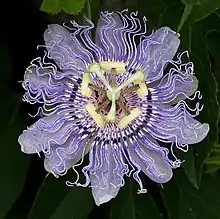 State wildflower - passion flower 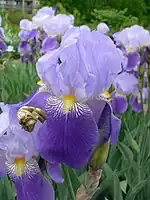 State cultivated flower - iris |
Tennessee has two state flowers. The purple passionflower (Passiflora incarnata) is the state's wildflower and the iris is the state's cultivated flower.
In 1919, the Tennessee General Assembly passed a resolution providing for a state flower to be chosen by a vote of the state's school children, with the process to be overseen by a five-member commission. The resolution stated "That the flower which shall be named by the school children and certified by the commission shall be recognized as the State flower." Shortly after the resolution was enacted, a newspaper listed children's favorite flowers as including daisy, elder bloom, goldenrod, red clover, rose, sunflower, water lily, wild rose, and violet. However, after the votes were counted, the commission announced that the school children had selected the passion flower, making it the state flower.[3] The purple passionflower, called ocoee by the Cherokee and colloquially known as "maypop", is native throughout the state and was reported to be abundant. By the early 1930s, flower gardening was growing in popularity, garden clubs were being organized, and Nashville had become known for the iris. Gardeners campaigned to have the iris designated the state flower, and in 1933 the General Assembly adopted a resolution stating "The State of Tennessee has never adopted a State Flower" and designating the iris as the "State Flower of Tennessee."[3] Because the General Assembly had designated the iris as the state flower without rescinding the previous designation of the passion flower, the state essentially had two state flowers until 1973. In that year the General Assembly resolved the confusion by designating the passion flower the state wildflower and the iris the state cultivated flower.[4] The act naming the iris as the state flower did not specify a particular color or variety of this diverse plant. However, according to the Tennessee Department of State the purple iris is generally considered to be the state flower.[5] |
| State fruit | |
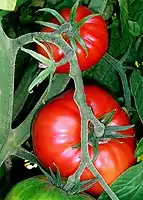 State fruit - tomato |
In March 2003, the General Assembly enacted chapter 154 of the Public Acts, designating the tomato as the official state fruit of Tennessee.[5] As of 2003, tomatoes were the state's largest fruit crop.[6] Grainger County and the Ripley area in Lauderdale County are principal areas for tomato production.[6] The legislation to designate the tomato was sponsored by state Representative Dennis Roach of Rutledge, in Grainger County.[7] No particular variety of tomato is specified.[7][8] |
| State birds | |
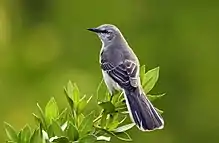 State bird - mockingbird |
Tennessee has two state birds. The mockingbird (Mimus polyglottos) was designated the state bird by the General Assembly in 1933. It had been selected earlier that year in an election conducted by the Tennessee Ornithological Society.[1]
The bobwhite quail (Colinus virginianus), also known as the partridge, was designated as the official state game bird by the General Assembly in 1988.[1] |
| State fish | |
 State sport fish - smallmouth bass  State commercial fish - channel catfish |
Tennessee has two state fish. The official state sport fish, designated in 2005, is the smallmouth bass (Micropterus dolomieu), a sought-after game fish.[9]
The state commercial fish, designated in 1988, is the channel catfish, Ictalurus lacustris, which is found in most Tennessee streams and many lakes and is widely stocked and reared in farm ponds.[1] |
| State wild animal | |
_2.jpg.webp) State wild animal - raccoon |
The raccoon (Procyon lotor) became the official state wild animal in 1971.[1] |
| State horse | |
 State horse - Tennessee Walking Horse |
The Tennessee Walking Horse was designated the official state horse by the 101st General Assembly in 2000.[1] |
| State reptile | |
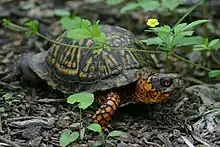 State reptile - eastern box turtle |
Tennessee's state reptile is the eastern box turtle (Terrapene carolina), designated in 1995.[1] |
| State amphibian | |
 State amphibian - Tennessee cave salamander |
In 1995 the Tennessee cave salamander (Gyrinophilu palleucus) was designated official state amphibian by the 99th General Assembly. This is a large salamander that lives in streams in limestone caves in the southern Cumberland Plateau and the Nashville Basin.[1][10] |
| State insects | |
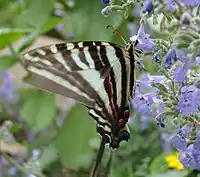 State butterfly - zebra swallowtail |
Tennessee has designated four different insects as official state symbols.
The firefly or lightning bug (Lampyridae family) and the insect known as ladybeetle, ladybug, or ladybird beetle, Coccinella septempunctata, were designated state insects by Public Chapter 292 of the Acts of 1975. The firefly species Photinus pyralis is the most familiar firefly species in the state.[1] In 1990, Public Chapter 725 designated the honeybee (Apis mellifera) as the official state agricultural insect.[1] Most recently, in 1995 the zebra swallowtail, Eurytides marcellus, was designated Tennessee's official butterfly by Public Chapter 896 of the 99th General Assembly.[1] |
| State rocks | |
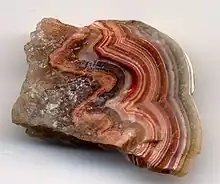 State rocks - agate  State rocks - limestone |
The Tennessee General Assembly has designated two different types of sedimentary rock as official state rocks.[1]
The agate was designated as the state's first official rock in 1969. A form of cryptocrystalline quartz (chalcedony) that is regarded as a semiprecious gemstone, agate is found in several areas in the state.[1] Collecting localities are found in Hawkins County (golden tone agate), Greene County (agatized oolites), Bedford County (carnelian, blue, ivory, pink, finely banded, dendritic, moss, iris and Fairburn style agate), and Shelby County (Lake Superior type agate and agatized corals and sponges).[11] Limestone, common throughout the state, was declared the official state rock in 1979. Tennessee marble, a limestone quarried in East Tennessee, is used as a building stone.[1] |
| State fossil | |
| Pterotrigonia thoracica was designated official state fossil in 1998, by the 100th General Assembly.[1] | |
| State rifle | |
| The Barrett M82/M107 was designated official state rifle in February 2016 by House Joint Resolution 231.[12][13] | |
State songs
In 2003, a resolution of the 103rd General Assembly designated songwriting as an official state art form.[1] In keeping with this designation, Tennessee has eleven official state songs:[1][14]
- "My Homeland, Tennessee", by Nell Grayson Taylor (words) and Roy Lamont Smith (music), was adopted as a state song by the General Assembly in 1925.
- "When It's Iris Time in Tennessee", by Willa Waid Newman, was designated a state song in 1935, two years after the iris became the state flower.
- "My Tennessee", by Frances Hannah Tranum, is the state's official public school song, adopted by the General Assembly in 1955.
- "Tennessee Waltz", by Redd Stewart and Pee Wee King, was designated an official song of the state by the General Assembly in 1965.
- "Rocky Top", by Felice and Boudleaux Bryant, was adopted as an official song of Tennessee in 1982.
- "Tennessee", by Vivian Rorie, was designated an official song in 1992.
- "The Pride of Tennessee", by Fred Congdon, Thomas Vaughn and Carol Elliot, was designated an official song in 1996.
- "Smoky Mountain Rain", a song written by Kye Fleming and Dennis Morgan that became a hit for Ronnie Milsap, was added to the list of state songs by the General Assembly on June 3, 2010, giving the state its eighth state song.[15][16] In the 2010 legislative session, the General Assembly also considered a resolution to designate "So I'll Just Shine in Tennessee" as a state song, but took no action on that proposal.[16]
- "Tennessee", written by John R. Bean of Knoxville, was designated an official state song in 2011.[17]
- "The Tennessee in Me", written by Debbie Mathis Watts, was designated an official state song in 2023.[18]
- "Copperhead Road", a song by Steve Earle about a man making moonshine and later growing marijuana in Tennessee, became a state song in 2023.[18]
Additionally, a rap song by Joan Hill Hanks of Signal Mountain, entitled "A Tennessee Bicentennial Rap: 1796-1996", was designated the state's "Official Bicentennial Rap" song in 1996. It was written "to provide a fun and easy way for citizens and students to learn and retain some of [the] state's history."[14]
State poem
A poem entitled "Oh Tennessee, My Tennessee" was designated the official state poem by the 88th General Assembly in 1973. The poem was written by U.S. Navy Admiral William P. Lawrence while in solitary confinement in a prisoner of war camp in North Vietnam.[1]
State folk dance
In 1980 the General Assembly designated the square dance as the state's official state folk dance, which it described as "a uniquely attractive art form that remains a vibrant and entertaining part of Tennessee folklore."[1]
See also
- Lists of United States state symbols
- Tennessine - an element named for the state
References
- 1 2 3 4 5 6 7 8 9 10 11 12 13 14 15 16 17 18 19 20 21 22 23 "About Tennessee: Tennessee Symbols and Honors" (PDF). Tennessee Blue Book, 2013-2014. Tennessee Department of State. 2013. OCLC 1253733.
- ↑ Tennessee State Flag Archived 2008-01-14 at the Wayback Machine, Tennessee Military Department website
- 1 2 Tennessee State Wildflower, NetState website, last updated March 30, 2006, accessed November 26, 2007
- ↑ State Symbols Archived 2008-11-20 at the Wayback Machine, Tennessee Secretary of State website
- 1 2 State Symbols and History: State Symbols Archived 2008-07-24 at the Wayback Machine, Tennessee Secretary of State website
- 1 2 Tasting Tennessee's State Fruit, press release, University of Tennessee Institute of Agriculture, August 4, 2003 (Accessed January 2, 2008)
- 1 2 Legislative briefs: House declares tomato Tennessee's state fruit, by Duren Cheek, The Tennessean, April 1, 2003.
- ↑ Arkansas State Fruit & Vegetable, NetState website, last updated October 9, 2007, accessed January 2, 2008
- ↑ "State Symbols - TN.Gov". TN.Gov. Retrieved May 19, 2016.
- ↑ Geoffrey Hammerson, Christopher Beachy (2004). "Gyrinophilus palleucus". IUCN Red List of Threatened Species. 2004: e.T59281A11896704. doi:10.2305/IUCN.UK.2004.RLTS.T59281A11896704.en. Retrieved 18 November 2021.
- ↑ Gordon T. Austin (1995), Chalcedony, in An Overview of Production of Specific U.S. Gemstones, U.S. Bureau of Mines Special Publication 14-95. U.S. Geological Survey website, accessed December 10, 2011.
- ↑ Sher, Andy (February 24, 2016). "Tennessee names the Barrett .50 caliber as the state's official rifle". Chattanooga Times Free Press. Retrieved February 26, 2016.
- ↑ Ebert, Joel (February 24, 2016). "Barrett M82 sniper rifle becomes official state rifle". The Tennessean. Retrieved February 26, 2016.
- 1 2 "State Songs". State of Tennessee. Retrieved December 29, 2018.
- ↑ Tennessee Journal, Vol. 36, No. 23, June 4, 2010
- 1 2 Tom Humphrey, 'Smoky Mountain Rain' Wins Race to Become 8th State Song Archived 2010-06-06 at the Wayback Machine, KnoxNews website, June 3, 2010.
- ↑ Humphrey, Tom (May 11, 2011). "Legislature OKs ninth state song". Knoxville News Sentinel.
- 1 2 Raucoules, Gregory (April 26, 2023). "'Copperhead Road' becomes Tennessee's newest official state song". WATE. Retrieved May 26, 2023.
External links
- Tennessee State Symbols at Tennessee.gov